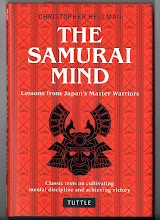Sunday 17 April 2011
Hirayama Shiryu - some stories
Hirayama Shiryu was a rare character, obsessive when it came to the world of bugei (martial arts). All the stories I have heard about him bear out his forceful character and his emphasis on determination and courage as the key components of martial arts. This example of his calligraphy reads "Angry Frog" - it can be pronounced onomatopoeically "Do-a". It refers to the story of a frog that announced it's defiance as one of the warlords of ancient China was invading a neighboring territory. It certainly displays vigor and energy in the two main characters, which accord well with Hirayama's martial character, as does the bravery of the small frog, but one should also pay attention to the signature at the side. The characters display grace and refinement, indicating that Hirayama developed skills that required more than sheer energy and determination. interestingly, this is also very visible in Musashi's painting and calligraphy, suggesting the high degree of physical control and finesse developed in traditional bugei. Interestingly, this quality is usually not present in the calligraphy of Zen priests, whose work often expresses forcefulness at the expense of flexibility. However, this more refined side of Hirayama's nature is something that does not normally come out in the stories about him.
As a young man, he was a student of Shibukawa Tokifusa, head the style of jujutsu of that name. Once, when practicing with the son of his master, he applied a shime-waza (strangle-hold) that left his partner unconscious. When he did not come to, Hirayama and his fellow students attempted to revive him, but to no avail. After many anxious minutes, he eventually came round. Throughout the whole incident, Hirayama retained his composure, despite the panic of his fellow students. When asked about it, he said that he had already resolved to take responsibility by committing seppuku, should their teacher's son have died, so there was no cause for alarm.
This is somewhat reminiscent of the attitude discussed in Yamamoto Tsunetomo's Hagakure, written a hundred years or so earlier. By Hirayama's time, this was somewhat outdated, I suspect, but it is worth noting that death by seppuku continued both as a judicial punishment and as a personal statement of responsibility until the beginning of the Meiji period, (and, indeed, in the latter case, beyond).
Another story that well illustrates his character is an episode that occurred with one of his friends, Shimizu Akagi, who was obviously of a similar mind to Hirayama. Walking home one cold evening in winter, Shimizu remarked "The heroes of old used to fight in the middle of winter. If we are serious about our martial studies, shouldn't we prepare ourselves for the same. How about a little swim?"
Hirayama, of course, agreed, so they both got into the icy water.
After finishing their swim and getting out, Hirayama proposed a nice bowl of hot noodles, to which his friend replied "Gotcha! They wouldn't have had that kind of luxury on the battlefield!"
Hirayama conceded the point, and they both went their separate ways home.
However, Hirayama's friend, on his way back, figuring Hirayama would go back home and be snuggled up warm in bed, thought he would surprise him and score double points. When he got to Hiryama's place, he was not in bed, but sitting on his normal oak board (which he used in place of a cushion), studying, according to his normal schedule. (In fact, he usually slept on the floor of his dojo rather than in a futon, with only a light cover, so I doubt he would have been getting very warm in any case).
Labels:
Heigen,
Hirayama Shiryu,
Martial arts,
samurai,
swordsmanship
Subscribe to:
Post Comments (Atom)











No comments:
Post a Comment